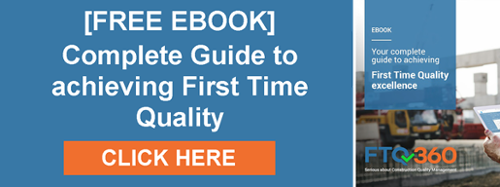
We’ve helped a lot of companies start a quality program, so we know the many pitfalls that can be avoided. While it’s likely that you’ll make a few mistakes along the way—who doesn’t? —understanding the most common errors before you get started can keep them to a minimum.
What is a Quality Program
A Construction Quality Program, which encompasses quality assurance and total quality management, ensures a project is completed within the defined guidelines set out in the Scope of Work. This document serves as a set of requirements for the project based on the owner's expectations and sheds light on how to execute it in a way that meets these standards while implementing quality assurance and total quality management principles.
6 Common Mistakes When Starting a Construction Quality of Work Program
Although every new quality program rollout is a little different and has its own unique bumps in the road, these six mistakes are the ones we see the most.
- Not Setting Measurable Construction Quality of Work Goals
- Creating Goals in a Vacuum
- Treating Your Quality Program as a Cost Center
- Implementing Too Much, Too Soon
- Doing Too Much Yourself
- Underestimating the Need to Build Consensus
1. Not Setting Measurable Quality Goals
Goals that are SMART—specific, measurable, achievable, realistic, and timely—are more effective than those that are not. For example, “We want to get better at first-time quality” is not a SMART goal. It’s on the right track (and a sentiment that we strongly support), but it is too vague to be effective.
On the other hand, “Our goal is to reduce deficiencies by 50 percent in the next six months” says a lot more about what you’re trying to achieve with your quality standards and that it is worthwhile endeavour.
Each member of the team will have a specific metric related to the production process to work toward, with the ultimate goal of improving customer satisfaction. This metric can be measured, has a timeline connected to it, and with the right systems in place, it is both achievable and realistic.
2. Creating Goals in a Vacuum
You can set all the goals and quality requirements in the world, but if you do so without input and buy-in from key stakeholders, you could be wasting your time.
Achieving first-time quality requires a team effort, and everyone must be on board in order for a quality program to be successful. Work with company executives to set goals that are meaningful to the company’s success. For example, if a 60 percent reduction in closeout punch can generate more business, then go for it!
Involve superintendents and project managers in the process as early as possible to ensure that your quality program is designed around their goals and challenges. Not only will you garner more support for the program, but your goals will be aligned with everyone else’s goals.
3. Treating Your Quality Program as a Cost Center
Is quality free? Not everyone may see it that way. However, by implementing continuous improvement processes, routine maintenance, and focusing on process output, first-time quality can actually be a cost-saving program in the long run. Introducing additional costs may cause some ripples, and these ripples can turn into waves if key stakeholders are not fully invested in the idea of quality as an investment for improving the overall efficiency of the process.
Budgets are a primary concern for project managers, superintendents, and top management, so it is important to address any concerns about cost and resources before they arise by demonstrating that a quality program can actually save money on projects and contribute to higher profits for the company.
Yes, a quality improvement program requires a financial investment, time, and other resources, but when key stakeholders understand that it can be a profit center, they are more likely to fully embrace it.
4. Implementing Too Much, Too Soon
Rolling out a construction quality program takes time. People have to learn new systems and change their behaviours. Many people also need to see the system in action before they’re fully convinced that they should adopt it.
Start with one project, one tech-savvy, open-minded superintendent, and a limited number of inspections, and add on your quality objectives from there. It won’t feel as intimidating to employees, and you will be able to refine the quality planning process as you continue to build the program.
Your quality program won’t be perfect the first time—or even the second or third time—but you will eventually have a system that works like a well-oiled machine.
5. Doing Too Much Yourself
“If I knew then what I know now….!” Starting a construction quality program comes with a lot of unknowns that can waste your time. Tap into the expertise of your software supplier and ask them for help and advice for getting your quality program started.
Identify one or two people on your team who can provide administrative support for your quality control program. As the quality manager, you must keep your eye on the big picture and not get buried in the minutiae.
6. Underestimating the Need to Build Consensus
No matter how good your construction quality program is, if you don’t have buy-in from all of the other stakeholders in the organization, it won’t reach its full potential.
Top management, superintendents, project managers, and even the IT department must be fully on board when implementing a new program. Building consensus for your quality program begins well before you start rolling out new systems.
Educate stakeholders about the many benefits of first-time quality and generate excitement about creating a quality program that can help you get there.
Starting a new construction quality program is an onerous task, but you don’t have to do it alone. Get coaching from other quality managers and people with industry experience so you can learn from their mistakes. FTQ360 is always here to help. Contact us if you’re ready to start your journey to first-time quality.
![[FREE EBOOK] Your Complete Guide to Achieving First Time Quality](https://no-cache.hubspot.com/cta/default/3353989/8c80b65c-b362-4e46-af1b-0ecf2d1581db.png)
